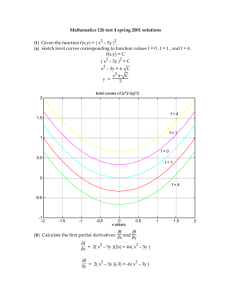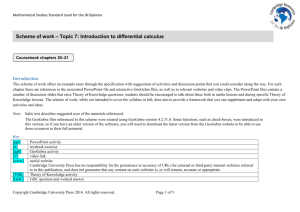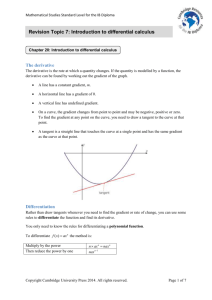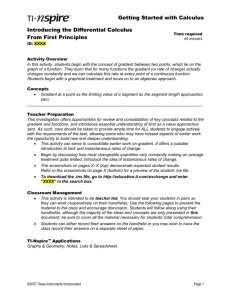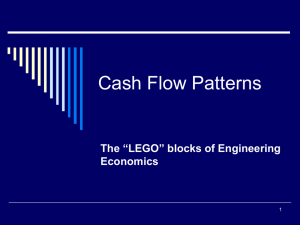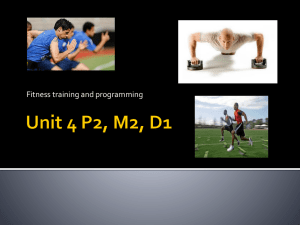IB Unit: Introduction to Differential Calculus
advertisement
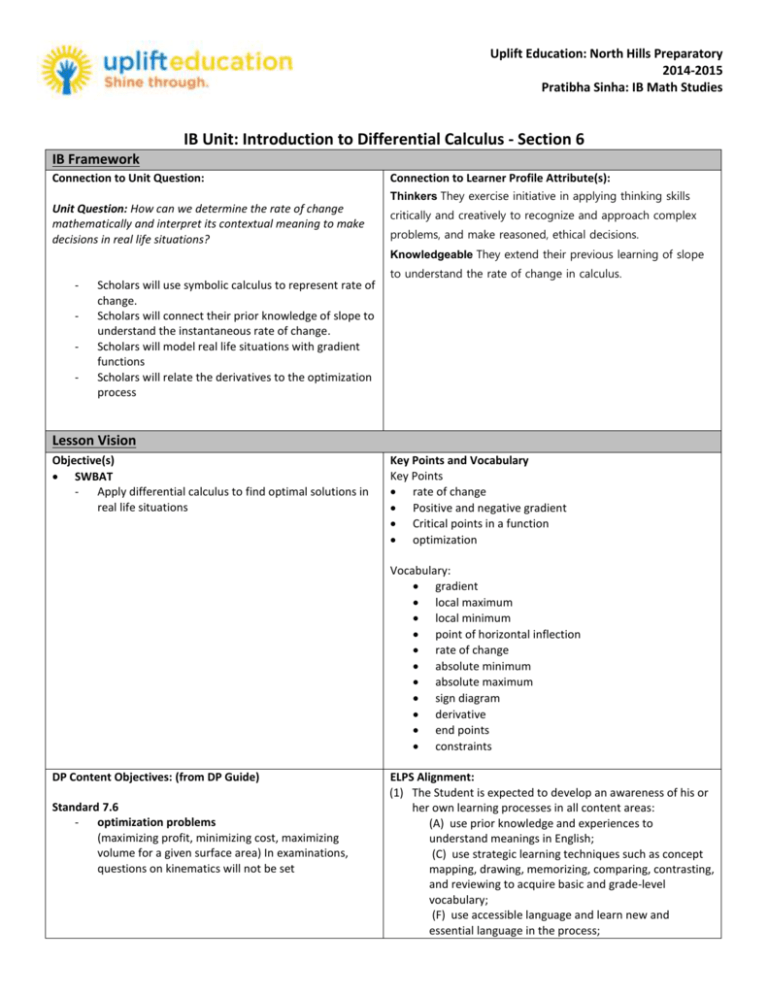
Uplift Education: North Hills Preparatory 2014-2015 Pratibha Sinha: IB Math Studies IB Unit: Introduction to Differential Calculus - Section 6 IB Framework Connection to Unit Question: Connection to Learner Profile Attribute(s): Thinkers They exercise initiative in applying thinking skills Unit Question: How can we determine the rate of change mathematically and interpret its contextual meaning to make decisions in real life situations? - Scholars will use symbolic calculus to represent rate of change. Scholars will connect their prior knowledge of slope to understand the instantaneous rate of change. Scholars will model real life situations with gradient functions Scholars will relate the derivatives to the optimization process critically and creatively to recognize and approach complex problems, and make reasoned, ethical decisions. Knowledgeable They extend their previous learning of slope to understand the rate of change in calculus. Lesson Vision Objective(s) SWBAT Apply differential calculus to find optimal solutions in real life situations Key Points and Vocabulary Key Points rate of change Positive and negative gradient Critical points in a function optimization Vocabulary: gradient local maximum local minimum point of horizontal inflection rate of change absolute minimum absolute maximum sign diagram derivative end points constraints DP Content Objectives: (from DP Guide) Standard 7.6 optimization problems (maximizing profit, minimizing cost, maximizing volume for a given surface area) In examinations, questions on kinematics will not be set ELPS Alignment: (1) The Student is expected to develop an awareness of his or her own learning processes in all content areas: (A) use prior knowledge and experiences to understand meanings in English; (C) use strategic learning techniques such as concept mapping, drawing, memorizing, comparing, contrasting, and reviewing to acquire basic and grade-level vocabulary; (F) use accessible language and learn new and essential language in the process; (2) The ELL listens to a variety of speakers including teachers, peers, and electronic media to gain an increasing level of comprehension of newly acquired language in all content areas: (E) use visual, contextual, and linguistic support to enhance and confirm understanding of increasingly complex and elaborated spoken language; (3) The ELL speaks in a variety of modes for a variety of purposes with an awareness of different language registers (formal/informal) using vocabulary with increasing fluency and accuracy in language arts and all content areas: (E) share information in cooperative learning interactions; ( (G) express opinions, ideas, and feelings ranging from communicating single words and short phrases to participating in extended discussions on a variety of social and grade-appropriate academic topics; (4) The ELL reads a variety of texts for a variety of purposes with an increasing level of comprehension in all content areas: (C) develop basic sight vocabulary, derive meaning of environmental print, and comprehend English vocabulary and language structures used routinely in written classroom materials; (5) The ELL writes in a variety of forms with increasing accuracy to effectively address a specific purpose and audience in all content areas: (B) write using newly acquired basic vocabulary and content-based grade-level vocabulary; Assessment: Problem: Accommodations/Modifications for Special Populations: All class notes, power points, and handouts available to scholars online on our class webpage at www.northhillsprep.org Visual as well as auditory presentation of information at all times. Opportunity for oral clarification or verbal delivery. Vocabulary definitions and clarifications as we read/real time. Movement and rotating partner collaboration. Preferential seating and active teacher monitoring. Teaching Plan Do Now Time: ___10_ minutes Hook Time: _5___ minutes Quiz – Rate of change problems and identifying maximum and minimum (IB test bank) Show scholars the map of the middle earth from ‘Lords of the Rings’ and discuss how Frodo’s journey was optimized for him to be successful. Discuss the all the possible options he had to complete the given task and how he made his decisions to be successful to bring scholars into the lesson Intro to New Material (I Do) Time: __20__ minutes Hands on ActivityScholars will work in partners. Hand out a grid paper to each of the pairs and ask them to draw four congruent squares in each corner of the paper (the size of the four corners has to be given by the teacher). Using the scissors and tape, they will then cut out the squares to create an open topped box. Then they are asked to record the width, length,and height of the box along with its volume. All groups record the data on the board and then they draw a graph to find the maximum volume and compare the size of the cut out corner. Connect this activity with the optimization process in calculus. Optimization Powerpoint presentation on optimization - Go over the problem solving method Draw a clear diagram of the situation Construct a formula with a variable to be optimized Find the derivative and find the values of x where it is zero Show the sign diagram using the domain and then test for a maximum or minimum Checks for Understanding, Exemplar Student Responses, Potential Misconceptions What is optimization? It is the process of finding the optimum solution using the maximum or minimum Does the maximum or minimum value always occur when the derivative is zero? No, it can also occur at the end points of the domain How can you test optimal solutions? Using sign diagram test or graphical test How do you find the derivative of a function? By using the power rule of differentiation How do you know if a function is increasing in a given interval? If the gradient of the tangent is positive, the function is increasing Why is the function increasing? Because the f(b) is more than f(a) where a and b are x values and a<b How can you identify the decreasing functions using the gradient of tangent lines? If the derivative value in the given domain is negative, the function is decreasing Explain why the function is decreasing using the x and y values. If f(b) is less than f(a); where a and b are any values in the domain and a is less than b What does the sign diagram represent? The sign diagram shows the critical points and how the gradient of the tangent lines vary in the various intervals in between. What are the critical values or stationary points? Critical values represent the points on a function where the gradient function or the slope of the tangent lines is zero. Misconception: Always make sure to keep the order same for x and y coordinates when finding the gradient. Intervals on the domain can be represented as an inequality or by using the interval notation. In the interval notation, both the value inside the parenthesis are representing xvalues or the domain of the function. In general, the rate of change of one variable with respect to another is the gradient function. Guided Practice (We Do) Time: 20____ minutes In Class Problems Scholars will work on the DP exam style practice problems in the powerpoint with the help of the teacher and their peers. They will use the information presented to them to solve the given problems together a group. We will have a discussion on the reasoning, rationale, and a way to crosscheck our answers as we go over these problems. Topics for lesson 6 are: - Using optimization to find desired solutions Checks for Understanding, Exemplar Student Responses, Potential Misconceptions What are the critical values? How do you find them? The critical values are the points in a function where the gradient of the tangent lines is zero. We can find them by making the gradient function equal to zero and then solving for x. Can there be more than one critical value in a function? Yes, there can be more than one critical value in a given function. The values are separated by a solid line if the value of x exist and with a dotted line if the function is undefined at those x-values. What do the signs represent on the sign diagram? The signs on the sign diagrams represent the value of the gradient function in that interval. How do you know if the function has a minimum point at a given critical point? If the sign of the gradient is negative on the left and positive on the right, the critical point represents a minimum. How do you identify a maximum point from a sign diagram? If the sign of the gradient is positive on the left and negative on the right, the critical point in between represents a maximum. How do you find the signs of the gradient function on the sign diagram? By substituting any x-value in the given interval, we can determine the sign of the function How can you use the GDC in optimization problems? - GDC can help you see the graph of the function and identify maximum/minimum - GDC can help you find the roots/x-intercepts/zeros of the first derivative MisconceptionsEmphasize that the derivative of a function is also a function and can be graphed Know that the variables in a function can change representing different quantities; so the notation of the derivative function may change too based on the situations it is used. Independent Practice (You Do) Time: __20__ minutes Ask the scholars to work on the powerpoint problems in class. Checks for Understanding, Exemplar Student Responses, Potential Misconceptions As the scholars work on the independent practice questions, ask them the following questionsWhat happens to the powers of the variables when you take the derivative of a function? The power of the variable goes down by 1 How do you take the derivative of a sum or difference? The rule states that the derivative of a sum (or a difference) is equal to the sum (or the difference) of the derivatives. If v is the velocity of an object, what does dv/dt represent? The dv/dt represents the rate of change of velocity with time which is equivalent to the acceleration. How would you decide by considering dv/dt whether the water was entering or leaving the container? If the value of the gradient is negative, the water is leaving and if the value of the gradient is positive, the water is entering the container. How can you double check your work? By using the graphing function on the GDC Misconceptions: Make sure that scholars understand that - the derivative is a function - it changes values as we move on the graph - it represents the slope at a given point on a graph - the derivatives of curves vary along the shape - the gradient of the tangent line can be used to determine if a function is increasing or decreasing - Closure and Exit Ticket Time: __10__ minutes check your answer by graphing the function on the GDC substitute the value of x in the gradient function to see if the slope at that point is positive or negative positive slope-means increasing function negative slope-means decreasing function zero slope means maximum or minimum the quadratic function has a negative coefficient shows a maximum point you can only use differentiation in functions with one variable Choosing which variable to eliminate is an important skill. A bad choice will make the function more complicated Closure: Summarize what you learned and decide the learner profile attribute that you exhibited today TOK moments Is optimization unique to mathematics? How does mathematics fit into the scientific method? Does mathematics have a prescribed method of its own? Is mathematics a science? Exit ticket Practice problem from the IB test bank Homework/Extension Scholars will take a quiz on optimization. Suggested homework: Topic 7 practice – all questions

